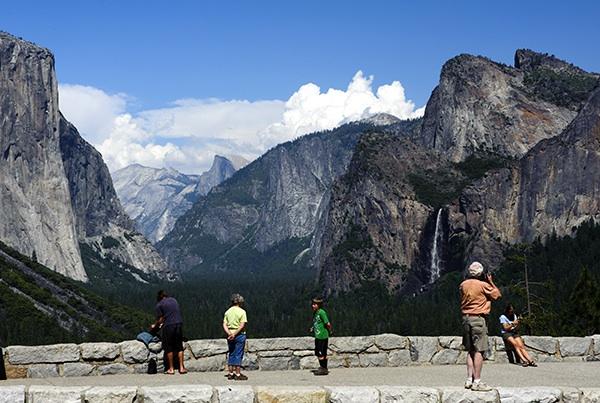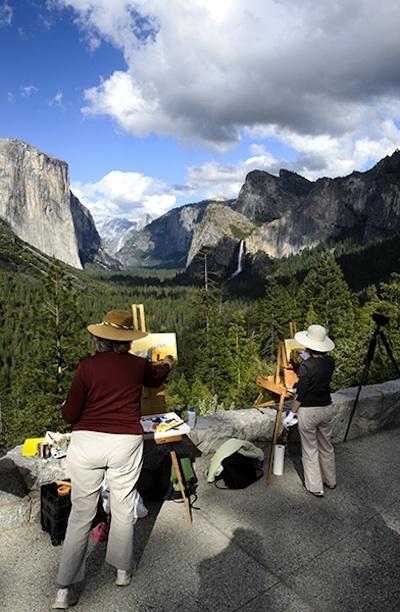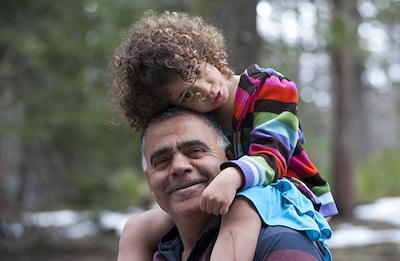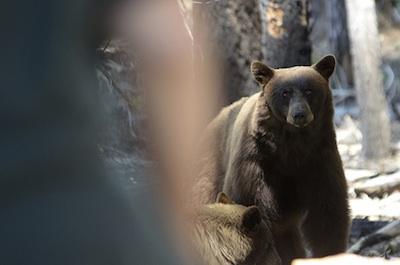
Add perspective and tell stories by inserting people into your shots. Deby Dixon photo.
I am a natural born writer but did not realize my passion for story-telling until finding photography with which to illustrate my words. Personally, I don't see the point in telling a story if it can't be punctuated by images.
The world of photography captures all kinds of images, from the wide-open, jaw-dropping gorgeous landscapes to the minute detail of a flower petal, and everything in between. The thing is, though, that everyone is after that gorgeous reflection of the Tetons in String Lake (Grand Teton National Park) with wild lupine in front, or of Mount Rainier in Reflection Lakes at sunrise, and so those images are nearly a dime a dozen. The secret to successful photography in our national parks and creating images that will be of interest to magazines, newspapers and the tourism industry is to show people using the spaces within the parks.
Fortunately, my photography career began with photojournalism and images that tell a story. And, as I have honed my powers of observation and composition, I have discovered that it is not only the people in the spaces but other subjects as well, that can tell the many stories of our parks. Thus, this column begins a series on making marketable images in our national parks and will conclude with low maintenance ways of marketing your photos.
How To Get People In Your Shots
So, let's start with photographing people in the enormous granite cliff landscape of Yosemite National Park, amongst the California Sierra Nevada range.

Deby Dixon photo.
Two years ago I had the great fortune of volunteering as a camp host in Yosemite, which enabled me to spend three months, rent free, in one of our most popular parks. Most of the action in this park is concentrated in the valley and a one-way loop drive that takes visitors past great viewing stops, waterfalls and many trails, putting them nearly every place that one wanders, and so it is much easier to simply embrace people in the landscape photos than to reject them. And, to tell the truth, when one gets up to Glacier Point or Sentinel Dome, (after it opens in the Spring) and looks out at the granite that spans across the way, making iconic formations, such as Half Dome, where there isn't a tree or a bush to use as a foreground element that breaks up the space and show scale, a person is a welcome substitute.
My own style of people photography is to take the opportunities that are handed to me. I love the candid moments and so rarely ever pose or even ask. I shoot first, ask questions later. It is perfectly legal to photograph people in public spaces and no photo release is needed if the image is going to be used for editorial purposes, such as for a story about the place. But if anyone asks me to not take or use a photo, for whatever reason, I respect their wishes. If I want to sell the image to a stock agency for commercial purposes, a photo release will be needed. And, being the 21st Century, there is an app for that: https://play.google.com/store/apps/details?id=com.docusign.ink for Android, and, https://itunes.apple.com/us/app/docusign-ink-sign-pdf-documents/id474990... for iPhone. No more excuses about not wanting to carry pen and paper - everyone always carries their smartphone.
I rarely look for a person in the landscape shot because that tends to take the "moment" out of the feel of the photograph. Instead, I allow my senses to be inspired by the light, the color of their clothing, their scale in the landscape and their activity.
For instance, there can be six people lined up, looking out across the way at Half Dome, and one might be wearing black, another white, another picking their nose and another tying their shoe, all four giving me the entire view of the granite sculpture while providing a sense of place and scale. And the remaining two can be not so cooperative in standing still and giving me a view of the entire dome, but be twins in bright colored, matching outfits, climbing on the rocks and I might be more apt to choose them because they are conveying fun for children in the park.

Deby Dixon photo.
One of the other important features I look for is different ethnic groups to show that our national parks are for everyone. And, so, when I find a beautiful, exhausted child in a colorful jacket, perched on the shoulders of her smiling grandfather, who, by the way, nodded yes to the photo, while exploring the Mariposa Grove, I take the shot. And, yes, later I regretted not having a photo release for them to sign, but I rarely do stock contracts because I prefer to stick with editorial usage of my images. That way I know what the photo will be used to represent.
Couples, young and old, having a quiet moment looking at the landscape, hikers, people stopping to rest, check their phones or have a picnic, and artists, painting or taking photos, are all great subjects to show how our parks are used. How people fit into the landscape of the wild.
Telling Stories
But, being the story-teller and educator of all things wild that I am, I also will respond to opportunities that will show people how not to act around wildlife or natural features. For instance, a man standing way too close to a bear. I am careful to try and not use these images to embarrass someone as much as to educate about being around wild animals because, if a person does something dumb that causes a wild animal to react in a defensive way, the wild animal usually pays the ultimate price. I don't take kindly to people bringing harm to the wildlife and so tend to think that education is a good dose of prevention.

Deby Dixon photo.
The bottom line, when you are thinking about taking marketable images of people in national parks is to think about what would attract you to that place. Will you look at an image of an old couple standing on Sentinal Dome, looking out at Half Dome and think, I need to do that before it is too late? Or, will you want to be the grandfather showing his granddaughter the beauty of nature? If you can put your thoughts onto what might sell you on visiting a place, then you can make an image that has market value. Then maybe you can buy a new lens or afford to travel to another park.
One last thing, I travel by myself because no one could possibly put up with my crazy schedule and so I always try to remember to set up the camera and tripod for a "selfie." Who knows, it might sell and you won't have to worry about getting a photo release, (it has happened) but, at the very least, you will have a memory of yourself when you were there.
Traveler footnote: Deby put her advice to work in capturing the cover photo for our Essential Guide To Paddling the Parks. It was taken in Yellowstone National Park during a kayak trip last summer.



Add comment